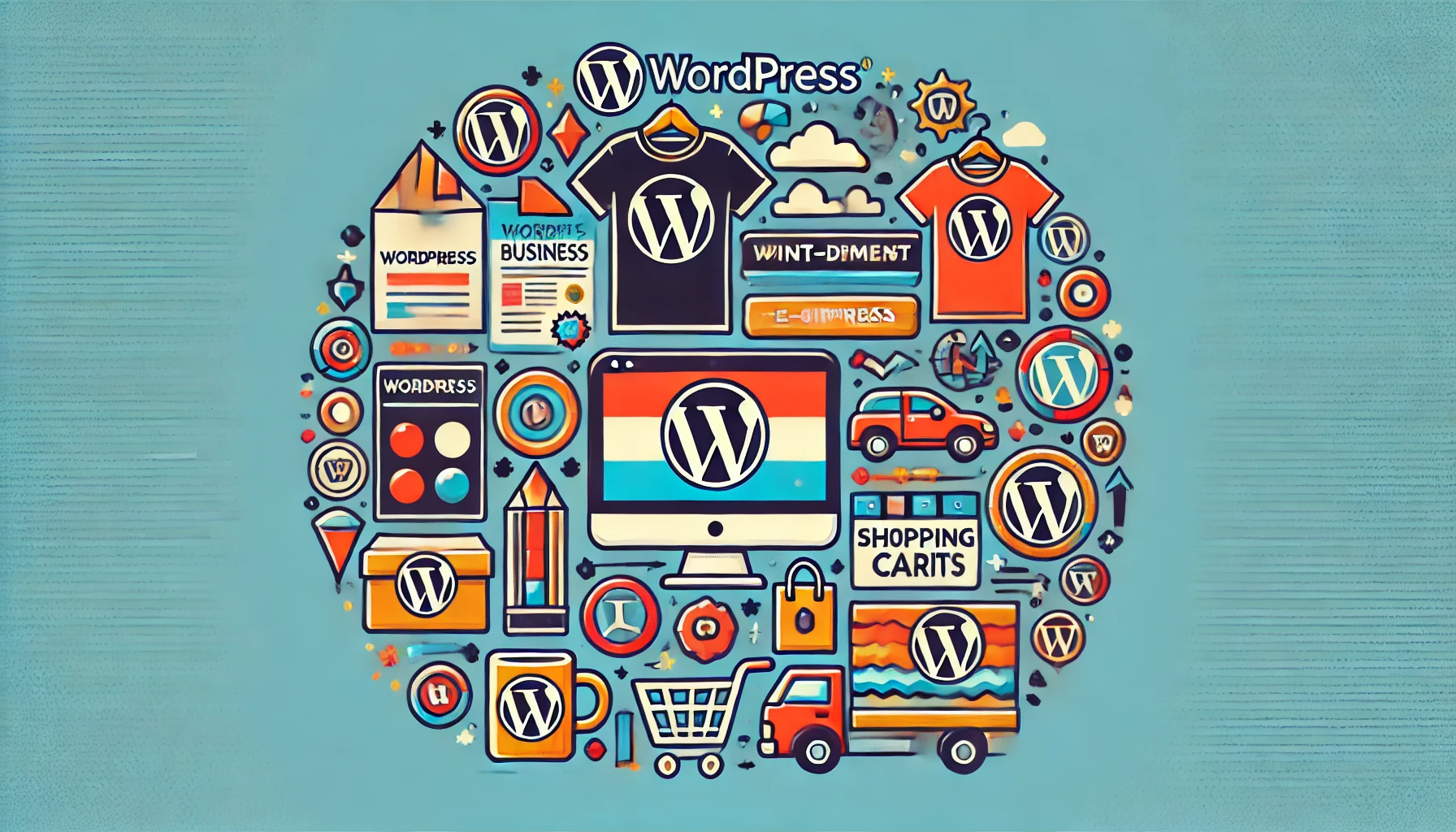Starting a print-on-demand (POD) business is an excellent way to sell custom products without holding any inventory. Print-on-demand services allow you to create designs that are printed on various products—like T-shirts, mugs, posters, and more—only after an order is made. This eliminates the need for upfront investment and storage costs, making it a perfect business model for beginners.
In this comprehensive guide, we’ll walk you through how to start a print-on-demand business using WordPress, one of the most flexible and powerful platforms for e-commerce. We’ll cover everything from setting up your WordPress site to integrating it with the best print-on-demand services, including Printful, Teespring, and Printify.
Why Start a Print-on-Demand Business?
Before diving into the step-by-step process, it’s essential to understand the benefits of starting a print-on-demand business:
- Low Start-up Costs: You only pay for the product after a sale is made, eliminating the need for upfront investments.
- No Inventory Management: You don’t need to worry about inventory, storage, or shipping logistics, as the print-on-demand service handles everything.
- Wide Range of Products: You can offer a variety of products, from apparel to home decor, without increasing operational complexity.
- Scalability: As your business grows, you can easily add new designs and products without additional investment.
- Global Reach: With a WordPress website and a print-on-demand service, you can sell to customers worldwide.
Step 1: Set Up Your WordPress Website
The first step to starting your print-on-demand business is to set up a WordPress website. WordPress is an ideal platform for e-commerce due to its flexibility, scalability, and compatibility with various plugins and services.
1.1 Choose a Domain Name
- Select a domain name that reflects your brand, is easy to remember, and relates to the products you plan to sell. Use domain registration services like Namecheap or GoDaddy to check availability and register your domain.
1.2 Choose a Hosting Provider
- For a smooth website experience, choose a reliable WordPress hosting provider like Bluehost, SiteGround, or HostGator.
- Install WordPress on your hosting account (most hosting providers offer one-click WordPress installations).
- Once installed, you can log into your WordPress admin dashboard and start customizing your website.
1.3 Select a WordPress Theme
- Choose a WordPress theme optimized for e-commerce, such as Astra, OceanWP, or GeneratePress.
- These themes are highly customizable, mobile-friendly, and compatible with WooCommerce, the e-commerce plugin we’ll use in the next step.
1.4 Install Essential Plugins
- WooCommerce: WooCommerce is the most popular e-commerce plugin for WordPress. Install and activate it to enable product listings, cart functionality, and payment gateways.
- Yoast SEO: This plugin helps you optimize your website for search engines, improving your visibility and organic traffic.
- WP Super Cache: This plugin helps improve website speed, which is essential for user experience and SEO.
Step 2: Set Up WooCommerce for Your Store
WooCommerce is the engine that powers your WordPress e-commerce store. It enables you to manage products, orders, and payments seamlessly.
2.1 Configure WooCommerce Settings
- After installing WooCommerce, you’ll be guided through a setup wizard.
- Store Details: Enter your store’s address, preferred currency, and type of products you’ll sell (physical products for print-on-demand).
- Payment Options: Set up payment gateways like PayPal, Stripe, or Square to accept payments from customers.
- Shipping Options: Even though your print-on-demand service handles shipping, you should configure basic shipping settings to align with your print-on-demand partner.
2.2 Add Print-on-Demand Integration
- WooCommerce supports integrations with various print-on-demand services. We’ll cover how to integrate with the top three providers: Printful, Printify, and Teespring.
Step 3: Integrate with Print-on-Demand Services
To automate product creation, fulfillment, and shipping, you need to integrate your WordPress site with a print-on-demand service. Let’s look at how to connect WooCommerce with Printful, Printify, and Teespring.
3.1 Integrate with Printful
Printful is one of the most popular print-on-demand services, known for its wide range of products, quality printing, and global fulfillment centers.
- Sign Up for a Printful Account: Go to Printful’s website, create an account, and fill in the required details.
- Install Printful Plugin: In your WordPress dashboard, go to “Plugins” > “Add New” and search for the Printful plugin. Install and activate it.
- Connect Printful to WooCommerce: Follow the instructions to connect Printful to your WooCommerce store. You’ll need to provide API credentials, which are available in your Printful account.
- Add Products: In the Printful dashboard, create products by choosing the product type, uploading designs, and setting pricing. Once created, products will automatically sync with WooCommerce.
- Manage Orders: When an order is placed, Printful will handle production and shipping. You can track order status directly from your WordPress dashboard.
3.2 Integrate with Printify
Printify is another top print-on-demand service that offers a wide selection of suppliers, competitive pricing, and multiple printing options.
- Sign Up for a Printify Account: Go to Printify’s website, create an account, and complete your profile.
- Install Printify Plugin: In your WordPress dashboard, go to “Plugins” > “Add New” and search for the Printify plugin. Install and activate it.
- Connect Printify to WooCommerce: Follow the prompts to link your WooCommerce store with Printify. You’ll need to provide API credentials, which are found in your Printify account settings.
- Add Products: Use the Printify dashboard to create and customize products. Select from a variety of product categories, including T-shirts, mugs, and phone cases.
- Manage Orders: Orders placed on your website will automatically be sent to Printify for fulfillment. Printify will handle production and shipping, and you’ll be able to track order status through WooCommerce.
3.3 Integrate with Teespring
Teespring, now known as Spring, is a print-on-demand platform that caters to content creators and influencers. It is easy to use and perfect for selling apparel, home decor, and digital products.
- Sign Up for a Teespring Account: Go to Teespring’s website, sign up, and complete your profile.
- Install Teespring Plugin: In your WordPress dashboard, go to “Plugins” > “Add New” and search for the Teespring plugin. Install and activate it.
- Connect Teespring to WooCommerce: Provide your Teespring API credentials to connect with WooCommerce.
- Add Products: Use the Teespring dashboard to design products, set prices, and add product descriptions.
- Manage Orders: Teespring manages order production and shipping, so you don’t have to worry about logistics.
Step 4: Create and Upload Product Designs
The success of your print-on-demand business largely depends on the quality and appeal of your designs. Here’s how to create compelling designs:
4.1 Use Design Tools
- Canva: A beginner-friendly design tool that offers templates for various products, making it easy to create eye-catching designs.
- Adobe Illustrator: Ideal for professional designers who want more control over vector graphics and high-quality designs.
- Placeit: Offers mockups, templates, and design tools specifically for print-on-demand products.
4.2 Optimize Your Designs
- Make sure your designs are high resolution (300 DPI) to ensure print quality.
- Keep designs simple and aligned with your niche to attract a specific audience.
- Use trending themes, phrases, or visuals to increase engagement and sales.
Step 5: Set Up Your Store and Optimize for Sales
With products added to your WooCommerce store, it’s time to optimize your store for conversions.
5.1 Add Product Descriptions
- Write compelling product descriptions that highlight the features and benefits of each product.
- Use relevant keywords in titles, descriptions, and meta tags to improve SEO.
5.2 Optimize Product Pages
- Use high-quality images and mockups that showcase the product.
- Include reviews, testimonials, and user-generated content to build trust with potential customers.
5.3 Set Up Payment Gateways
- Ensure that payment gateways are set up correctly to accept various payment methods like credit cards, PayPal, and Apple Pay.
5.4 Implement Upsells and Cross-Sells
- Use WooCommerce plugins like WooCommerce Upsell and Cross-Sell to suggest related products and increase average order value.
Step 6: Market Your Print-on-Demand Store
Effective marketing is essential for attracting customers and driving sales.
6.1 Use Social Media Marketing
- Promote your products on platforms like Instagram, Facebook, and Pinterest. Use hashtags, engage with followers, and run paid ads to reach a larger audience.
6.2 Implement Email Marketing
- Collect emails using tools like Mailchimp, ConvertKit, or Klaviyo to build an email list.
- Send regular newsletters, promotional emails, and exclusive offers to your subscribers.
6.3 Run Google and Facebook Ads
- Set up targeted ad campaigns on Google and Facebook to drive traffic to your store. Use retargeting ads to convert potential customers who visited but didn’t purchase.
6.4 Use SEO to Drive Organic Traffic
- Optimize your website’s content, images, and metadata for search engines to improve your ranking and attract organic traffic.
- Create a blog with content related to your niche and link it to your print-on-demand store to boost SEO.
Step 7: Track Your Sales and Optimize Performance
To grow your print-on-demand business, it’s important to monitor your performance and make necessary adjustments.
7.1 Use Google Analytics
- Set up Google Analytics to track visitor behavior, sales, and conversion rates. Analyze which pages and products perform best and identify areas for improvement.
7.2 Monitor Product Performance
- Use WooCommerce reports to track product sales, top-performing items, and customer feedback.
- Adjust pricing, marketing, or product offerings based on performance data.
Final Recommendations
Starting a print-on-demand business with WordPress is a scalable and profitable venture. Here’s a quick recap of the process:
- Set Up WordPress: Choose hosting, install WordPress, and configure WooCommerce.
- Integrate Print-on-Demand Services: Connect with Printful, Printify, or Teespring for seamless fulfillment.
- Create High-Quality Designs: Use design tools and optimize for print quality.
- Market Your Store: Use social media, email marketing, and paid ads to drive traffic and sales.
- Track and Optimize: Use analytics to measure performance and refine your strategy.
Conclusion
Starting a print-on-demand business with WordPress is not only cost-effective but also a low-risk way to enter the e-commerce space. By following this step-by-step guide, you can set up a fully functional POD store and start generating revenue with minimal upfront costs.





0 Comments